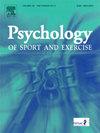The structure of executive functions in athletes: A latent variable approach
IF 3.1
2区 心理学
Q2 HOSPITALITY, LEISURE, SPORT & TOURISM
引用次数: 0
Abstract
The role of executive function (EF) in expert sport performance has become a popular topic in sport and exercise psychology research. Research in this area often adopts the unity/diversity framework of EF (i.e., inhibition, shifting, and updating). However, recent investigations into the suitability of this unity/diversity model, and other competing models (e.g., the nested model of EF), has questioned whether this model is suitable for across all populations (e.g., athletes). The aim of the present study was to use confirmatory factor analysis to outline the most suitable EF model in a sample of athletes. In total, 131 participants with varying levels of athletic expertise completed two inhibition, shifting, and updating tasks. All analyses were performed in RStudio. The results revealed the nested model of EF provided the best fit to the data indicating its suitability for athletes. Acceptable fit was also found for the unity/diversity mode of EF. Overall, the results suggest that, despite recent criticism of the nested model and unity/diversity framework of EF, such structures appear to be suitable for use with athletic populations.
运动员执行功能的结构:一种潜在变量方法。
执行功能(EF)在专家运动表现中的作用已成为运动心理学研究的热门话题。这方面的研究通常采用EF的统一性/多样性框架(即抑制、转移和更新)。然而,最近对这种统一/多样性模型和其他竞争模型(例如EF的嵌套模型)的适用性的调查,质疑该模型是否适用于所有人群(例如运动员)。本研究的目的是使用验证性因子分析来概述运动员样本中最合适的EF模型。总共有131名具有不同运动专业水平的参与者完成了抑制、转移和更新两项任务。所有分析均在RStudio中进行。结果表明,嵌套的EF模型对数据的拟合效果最好,表明其对运动员的适用性。EF的统一/多样性模式也得到了可接受的拟合。总体而言,结果表明,尽管最近对EF的嵌套模型和统一性/多样性框架提出了批评,但这种结构似乎适用于运动人群。
本文章由计算机程序翻译,如有差异,请以英文原文为准。
求助全文
约1分钟内获得全文
求助全文
来源期刊
CiteScore
6.40
自引率
5.90%
发文量
172
审稿时长
69 days
期刊介绍:
Psychology of Sport and Exercise is an international forum for scholarly reports in the psychology of sport and exercise, broadly defined. The journal is open to the use of diverse methodological approaches. Manuscripts that will be considered for publication will present results from high quality empirical research, systematic reviews, meta-analyses, commentaries concerning already published PSE papers or topics of general interest for PSE readers, protocol papers for trials, and reports of professional practice (which will need to demonstrate academic rigour and go beyond mere description). The CONSORT guidelines consort-statement need to be followed for protocol papers for trials; authors should present a flow diagramme and attach with their cover letter the CONSORT checklist. For meta-analysis, the PRISMA prisma-statement guidelines should be followed; authors should present a flow diagramme and attach with their cover letter the PRISMA checklist. For systematic reviews it is recommended that the PRISMA guidelines are followed, although it is not compulsory. Authors interested in submitting replications of published studies need to contact the Editors-in-Chief before they start their replication. We are not interested in manuscripts that aim to test the psychometric properties of an existing scale from English to another language, unless new validation methods are used which address previously unanswered research questions.

 求助内容:
求助内容: 应助结果提醒方式:
应助结果提醒方式:


